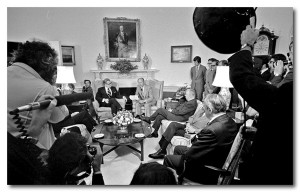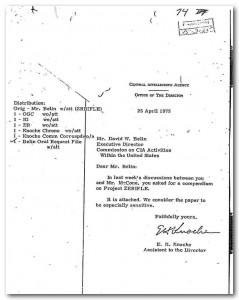SY HERSH AND THE KENNEDY-CAMPBELL AFFAIR
The genesis of JFK’s affair with Judith Campbell began with a 1960 plot by Chicago Mafia chieftain Sam Giancana to ensnare the senator into a relationship with her. Giancana’s original motive was to increase his leverage over the Kennedy family. He used his lieutenant Johnny Roselli to engineer this sordid scheme. The exposition of Giancana’s plan led to appalling and tragic unintended consequences when it became entangled in the Central Intelligence Agency’s plan to use him to assassinate Fidel Castro. Those consequences included the assassination of President Kennedy on 22 November 1963, the assassination of Giancana on 19 June 1975—the day before his and Judith Campbell’s scheduled appearances before the Church Committee—and the assassination of Roselli in August 1976.
Only Judith Campbell lived to tell the story about her role as a courier between JFK and Giancana. But years passed before she dared to discuss it. She gave a detailed accounting of her courier work to investigative journalist Sy Hersh about two years before her death from breast cancer in 1999. Because Hersh’s track record includes several examples of questionable (to say the least) reporting, his publication of Campbell’s courier role in his book The Dark Side of Camelot has not been well received by the public and by some of the JFK research community whom I both know and respect. It is well known that a month before publication of Hersh’s book, a segment about legal documents allegedly containing JFK’s signature was removed from the galleys. That segment was based on fraudulent documents created by a paralegal, Lawrence Cusack, alleging that JFK had arranged for hush money to keep details of an affair with Marilyn Monroe quiet.
I am aware of Sy Hersh’s 1968 role as press secretary to Eugene McCarthy, Richard Goodwin’s defection to join the Kennedy campaign on the eve of the Indiana Primary, and of Hersh’s bitterness that came as the result of Robert Kennedy getting into the race after assuring Kennedy loyalists and antiwar leaders that he would not challenge the Democratic Party nominee. In spite of the drawbacks to Hersh’s take on JFK, I realized that in researching and writing Countdown to Darkness there was no way around evaluating three of Hersh’s claims in The Dark Side of Camelot: 1) the Campbell courier role between JFK and Giancana, 2) the Clarence B. Sprouse fall 1960 briefing for JFK about the CIA plan for the exile invasion (and Alabama Governor John Patterson’s warning to JFK about the same subject),[1] and, 3) with just two weeks to go before Election Day, JFK’s alleged note to himself to talk to Allen Dulles to make sure nothing would be done about Cuba before the election.[2]
The alleged courier role played by Campbell between JFK and Giancana cannot be casually dismissed simply because Hersh wrote about it. Anthony Summers and Robbyn Swan also realized they had to vet the courier story for their 2005 biography Sinatra: The Life. Summers and Swan offered this observation:
Yet much of what Campbell claimed is credible. A good deal of it is supported by phone records, White House logs, and other documentation. Interestingly, some of her more controversial claims, suspect because she did not make them publicly until many years had passed, were first made contemporaneously as private confidences.[3]
I agree that there is supporting documentation that supports the credibility of her claim. It needs to be further evaluated, and I will deal with this documentation in greater detail in Volume III, Into the Storm. I also agree that only speaking contemporaneously about her courier work in private helps the claim’s credibility. Yet, I would also think that keeping it private until many years had passed makes it more likely, not less, that Campbell’s claim might be true. If she made up this story for money, we would expect to have seen it used in her autobiography My Life. But she didn’t.
It is sensible to point out that Judith Campbell had good reason to keep her courier role secret for many years after her appearance before the Church Committee. In that appearance she was not under oath, and she denied having done anything for John Kennedy. As I mentioned above, the evening prior to her appearance before the committee, one end of the courier operation, Sam Giancana, had been assassinated. JFK, the other end of that operation, had already been assassinated in 1963.
All of the books about Campbell that I have searched—and I make no claim to having seen all that have been published—have failed to point out that Campbell gave details of her courier role publicly on national television five years before her interviews with Hersh. During a 4 February 1992 interview on Larry King’s television show, Campbell told the astonished talk show host that, during a 6 April 1960 dinner, Kennedy had asked her to set up a meeting with Giancana and take a “satchel” to him containing “a great deal of money.” I watched the interview live when it took place in 1992, and I reprinted the relevant extract from the transcript in Countdown to Darkness.[4]
Had the only source of Judith Campbell’s role as a courier between Kennedy and Giancana been Sy Hersh, then I would look upon this allegation with suspicion. But there is much more than Sy Hersh to consider in this matter. If her affair with JFK had taken place outside of the context of the CIA’s plot to use Giancana to assassinate Fidel Castro, then I would not have delved so deeply into the matter. However, given the way events unfolded in the fall of 1960, there was no way to avoid it.
What I offered in the present volume is only the beginning of the CIA-Mafia entanglement with this affair. The Giancana-Roselli relationship that developed out of these events has long legs looking forward in my plans for further investigation of the assassination of President Kennedy.
[1] I have submitted a FOIA request to the CIA for any documents made in connection with the Sprouse briefing.
[2] I have submitted research requests with the JFK Library about this and plan spending time there looking for this and other important documents that might help explain the raw hatred for Kennedy that followed his handling of the Bay of Pigs.
[3] Anthony Summers and Robbyn Swan, Sinatra the Life (New York: Vintage Books, 2006), p. 265.
[4] See p. 204.



